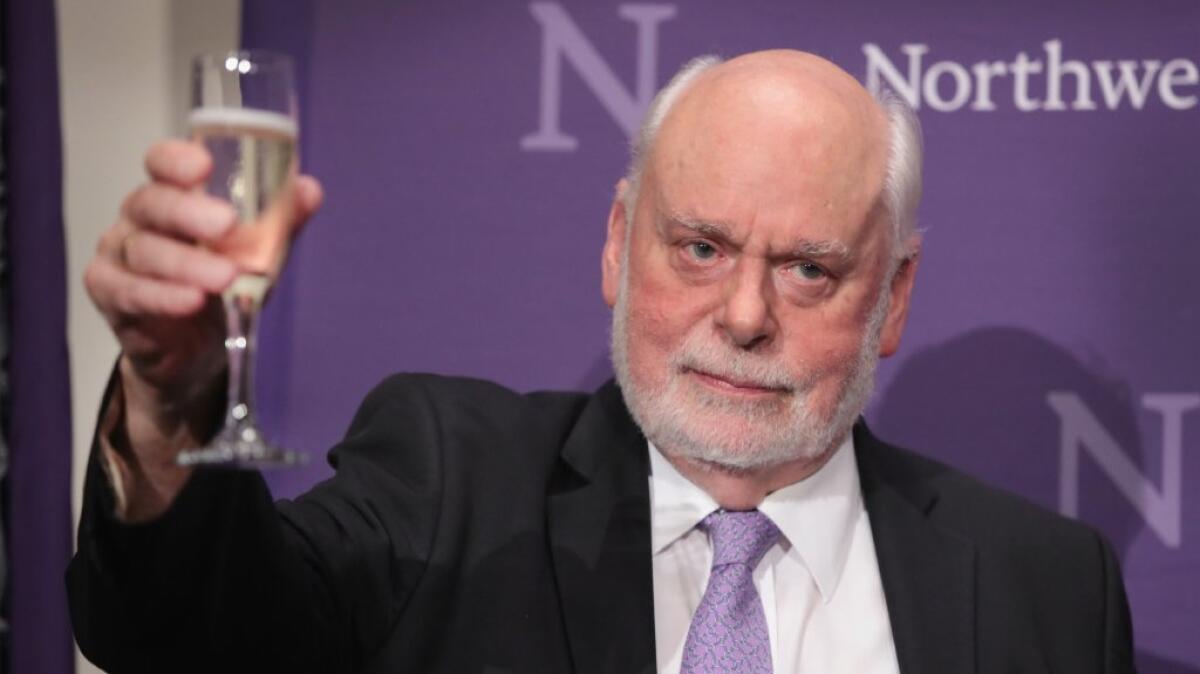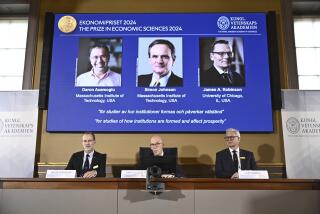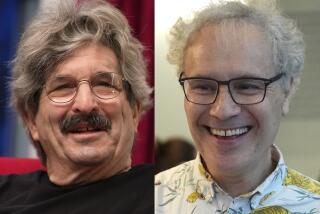Two Nobel-winning scientists left their mark on Southern California

While the 2016 science Nobel laureates hailed from well outside the Golden State, three local universities celebrated two winners with a California connection: physics laureate Duncan Haldane and chemistry laureate Fraser Stoddart.
Haldane, currently of Princeton University, previously taught at USC and UC San Diego; Stoddart, now at Northwestern University, spent a decade at UCLA. Each left a lasting legacy on the Southland — and for Stoddart, Los Angeles may have made a mark on him.
Coming to UCLA in 1997 from England presented a surprising set of challenges, said the Scottish-born Stoddart, who shares the 2016 chemistry Nobel with two other scientists.
“I more or less had to start again as an assistant professor,” he explained, “who then had to learn the ropes of a completely new academic culture that was quite different from that in the United Kingdom.”
He soon realized that those cultural differences actually presented scientific opportunities.
“The structure is more horizontal,” Stoddart explained. “So I had left a rather hierarchical system for a horizontal one, and that horizontal nature lends itself to collaborations.”
Stoddart soon began working with other scientists on research related to building tiny molecular computers and systems for drug delivery in the body.
“UCLA was a brilliant time for pushing these two potential applications, while still doing a lot of fundamental work,” he recalled.
Stoddart also led UCLA’s California NanoSystems Institute, where he oversaw a stage of growth that ultimately helped the university become a leader in the study of nanotechnology, said Miguel García-Garibay, UCLA’s dean of physical sciences.
“He’s one of the scientists that is best as a collaborator,” García-Garibay said, calling him “a real, good model of what a good scientist should be.”
Stoddart, who remains a professor emeritus at UCLA, moved to Northwestern in 2008 — but left an indelible impression on his California colleagues.
“Fraser was so excited about science, and his enthusiasm about the work he was doing was just contagious,” said Catherine Clarke, chair of UCLA’s department of chemistry and biochemistry. “He just loved what he did. He lived and breathed his science.”
Stoddart, who called himself “addicted to science,” said there are still plenty of days where he’s in the office around 6:30 a.m., ready to do more research.
“We speculated on whether he ever slept or not,” said Kendall Houk, an organic chemist at UCLA.
Stoddart’s wife, Norma, was a biochemist who also worked in his group, and beloved on campus. She passed away in 2004 after a long battle with breast cancer. He and his daughters endowed an annual chemistry prize for graduate students at UCLA in her memory, Clarke said.
“Not only does it honor that student for their academic excellence and research but also for their contribution in service and citizenship,” she explained. “And that feature of the prize really honors Norma ... she was so collegial, and everyone just loved her.”
The physics Nobel Prize also yielded a California connection: Duncan Haldane, currently of Princeton University, who previously taught at USC and UC San Diego.
Haldane, who was born in England and shared the physics Nobel with two others, won for his work on how condensed matter behaves in extreme states.
Ivan Schuller, a solid-state physicist at UC San Diego, remembered Haldane as being shy but friendly.
“He had somewhat of a genius kind of an aura,” he said. “The thing that he does is not simple. Even for us professors of physics, it’s not easy to understand.”
Much of the work that earned him the Nobel was done while he was at UC San Diego, said Daniel Arovas, a UCSD condensed matter theorist who worked with Haldane as a graduate student.
“There are a lot of very funny ‘absentminded professor’-type stories about him that we all tell at conferences — everybody has their favorite Duncan story,” he said, chuckling.
Arovas, who called Haldane “an original thinker,” said the newly minted laureate was the kind of scientist who would take the time to sit down and explain his ideas to anyone, from professors to undergraduate students.
“He’s really one of the good people,” he said.
Follow @aminawrite on Twitter for more science news and “like” Los Angeles Times Science & Health on Facebook.
MORE IN SCIENCE
Three scientists who created nano-sized machines win Nobel Prize in chemistry
Nobel Prize in physics honors 3 scientists for work that reveals the secrets of ‘exotic matter’
Japanese scientist Yoshinori Ohsumi wins Nobel Prize in medicine for work on cellular ‘recycling’







